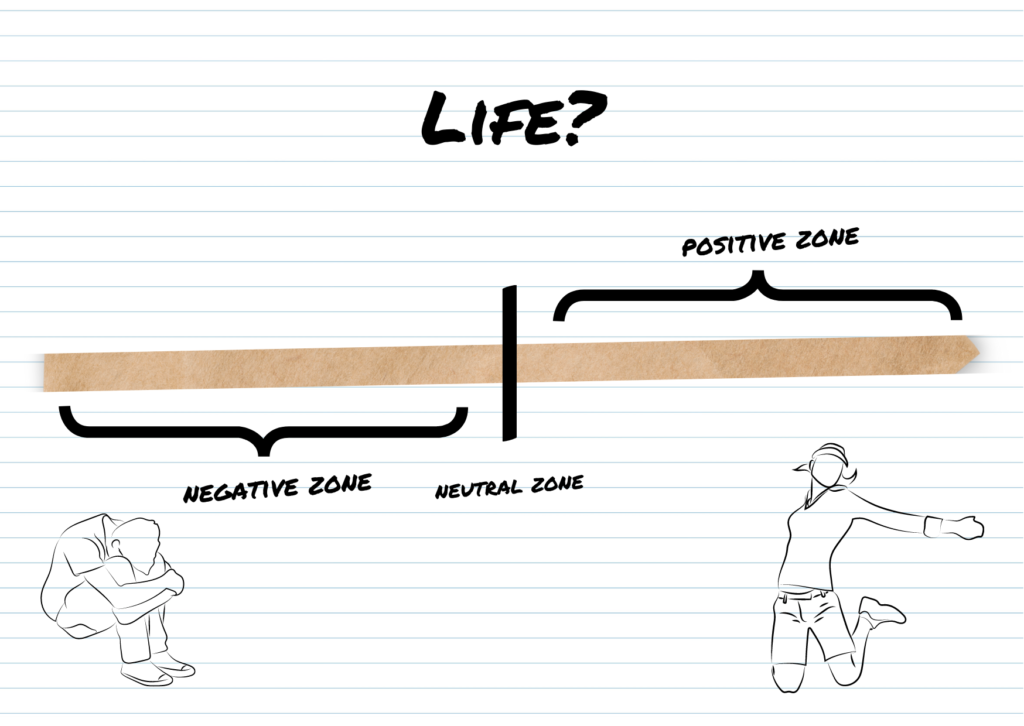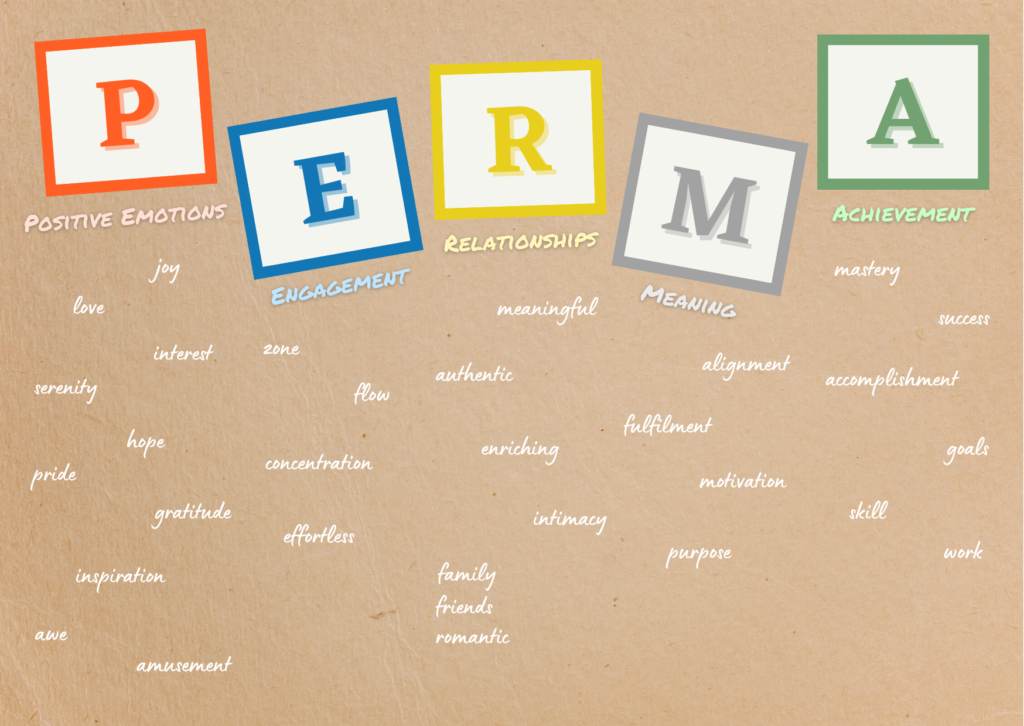To kickstart the new year, I would like to offer some tips from positive psychology for how we may lead a more positive life. Before that, we ought to ask why that matters. Why should we aim for a positive life?
Case for a Positive Life
Another way of asking the question might be: Why should we be contented with a non-positive life? What do I mean by a non-positive and positive life?
Let us imagine a life of mostly pain and suffering. I cannot think of anyone who consciously wants that. Yet, there are many people who dwell in this negative zone of life. Some of the worst pains come from factors outside our control (e.g. abuse, illness) but a large part of it comes from how we deal with pain itself. Common sayings like “Life is hard” can instill the belief that life is an inherently negative experience.
What if one is lucky enough to have a relatively smooth-sailing life without any harsh difficulties? It can be called the neutral zone of life, where we are alive and existing. We may question if that is all to it too. Is life void of any higher meaning? Did we just come here to go through a borderline experience?
Not exactly. Given a choice (which we all are), I bet most of us would want to go above and beyond.
Picture what I am saying along this spectrum.

Where are you currently at?
To find out, ask yourself this one simple question: How do I feel about life?
If your answer is an internal scream of “I HATE life!”, you know where you are. If it is a “I LOVE life!”, I give my heartiest congratulations to you! If it is a “OKAY, I guess…”, you are probably still figuring things out which is fine.
Here is a piece of good news.
No matter where you are on, there is the ever-present opportunity for moving upward.
Everyone has won the lottery to be alive in this world. What is stopping you from saying “I LOVE life!” with all the enthusiasm you can summon from your aliveness?
Moving Upward
Of course, we have to acknowledge that life is not a bed of roses. No one is spared from challenges along their journey.
The key is how we manage these challenges. And an indicator of how well we manage these challenges is in the level of transformation we create.
When an individual is faced with an adversity, there is a set of possible outcomes.
- Succumb (death)
- Survive (to a state worse than before)
- Recover (to the original state)
- Thrive (to a state better than before)
Often, we refer to the victims who made it through tragic incidents as “survivors”. However, the term “survivor” implies that surviving is the best outcome which does not really do justice to what they had to suffer. It overlooks the fact that something more meaningful can arise from what they have been through.
For example, there is a concept known as “Post-traumatic growth” whereby tremendous positive psychological changes happens to an individual after a traumatic event.
If thriving is possible even in the worst circumstances, it should offer us hope that it is possible in all circumstances for anyone.
We all have the potential to lead a thriving existence. To thrive can be said to be the meaning of life.
The only way is up, up and UP.
Perception is Reality
Admittedly, I used to think that optimism is a superfluous thing. I did not understand what the reason for optimism was other than for individuals to deceive themselves into feeling good. I was irked by the blind positivity I observed around me.
Having been brought up under a pessimistic environment, I had been conditioned to assume the worst of everything. Overtime, I learned how miserable it is to live life with such dark-tinted lenses.
Because your perception is what determines your reality.
If you choose to view the world with an optimistic outlook, you will experience a wonderful world. On the contrary, if you choose to view the world with a pessimistic outlook, you will experience a harsh and ugly world.
Regardless of what lies in the world objectively, our lived experiences can be said to be highly subjective according to our perceptions.
Why would we say no to the best things that the world has to offer when it is right within reach?
Here is another piece of good news: optimism is a choice and can be developed with practice.
Rules for Optimism
Now that the case for positivity has been argued for, it is time to examine how we may develop optimism as a tool to move towards a positive life.
Curbing Catastrophic Thoughts
From time to time, things happen. While we may not be able to control these events, we can control the way we think about them.
It is important to learn how to curb catastrophic thoughts because our brains are wired in a way to assume the worst-case scenarios first. If we give in to these thoughts, it can make matters worse.
For example, what would you assume about a situation where someone you know walked past you without saying hi?
Your first thought might be “That person is ignoring me on purpose.”. It might go down a slippery slope of “That person does not like me.” or “That person does not think I am worth paying attention to.”.
Yet, the truth could be further than that. What if the person was simply too engrossed in something else to notice you or was going through a difficult time?
The tendency to catastrophise does not stop here. When a similar event happens again, you may be tempted to make a connection between these events, thinking that “I must be an unlikable person.”. If it happens again, you may believe that “I will never be likable”.
Just because of a few assumptions, your perception of things have changed drastically.
Catastrophic thinking can happen in many everyday scenarios. Learn to spot it and curb it.
As a rule, do not jump to negative conclusions. Expect that similar events may happen, and even imagine that they may happen over and over again. Yet, never choose to believe that those isolated or temporary events could be related or permanent!
Cultivating Gratitude
The next thing is to cultivate gratitude.
Your focus determines your reality too.
If you choose to focus on the things that are going well, you will open up access to pleasant energy. When you are in a positive state, your presence alone will be uplifting for others. People will naturally want to get closer to you.
Gratitude can be cultivated through the conscious effort to do so. A study found that people who practiced describing 3 things they were grateful for daily had an increased sense of well-being.
Celebrating Moments
Many people would rather dwell on moments of failure than on the moments of success. If life has its fair share of failures and success, does it make sense that we pay more attention to only one side of it?
They say that it is the small things in life that matter. Indeed, that is why we should celebrate successes from the small ones to big ones.
“Celebrating” seems vague. How does one go about celebrating something?
When we look at the intention behind it, it is to amplify the happiness that can possibly be experienced from an event.
If someone ever tells you good news, you can practice a method of responding called Active Constructive Responding (ACR). Channel real enthusiasm and let the other party relieve their experience to you. This is the best response compared to other types (Active Destructive/Passive Constructive/Passive Destructive) as it maximises happiness on both ends.
It may not be more moments of success that we need, but knowing how to celebrate them that can make our lives feel replete with joy and fulfilment.
Building Blocks of a Positive Life
Besides learning to become optimistic, it helps to know which areas of your life to pay attention to and strengthen the foundations of.
The founding father of positive psychology, American psychologist Martin Seligman, created the PERMA Model which consists of 5 elements for well-being. I really like this model as I think it is a useful reference for building a positive life.

I will just briefly elaborate on each of the building blocks.
1. Positive Emotions
We always hear “Don’t worry, just be happy”. What does it mean to be happy? In fact, happiness is an umbrella term for a myriad of positive emotions.
According to American psychologist Barbara Fredrickson, the 10 most common positive emotions are joy, gratitude, serenity, interest, hope, pride, amusement, inspiration, awe and love. Which one of these do you relate to?
Although a few of these emotions can spontaeneously arise, we may need to create the situations conducive for it to arise. For example, by taking a risk to explore the less known.
The greater the amount and the broader the range of positive emotions that we are able to experience, the higher the sense of well-being.
2. Engagement
Engagement is closely related to a concept known as being in the “flow” or “zone”.
When one is engaged with what they are doing, a strange phenomenon occurs. The task at hand does not feel like a chore anymore but feels almost effortless.
If you involve yourself in engaging activities in most of your waking time, life does not have to feel so much like a chore (which it should not be in the first place!)
3. Relationships
As human beings, we cannot live without relation to one another.
We strive for deep relationships that mutually enrich instead of shallow relationships that are built upon superficialities.
In the past, I used to reject human relationships due to the pain from dysfunctional relationships and the prevalence of superficiality. However, things changed when I decided to settle for nothing less than meaningful relationships. I was touched when friends first told me that they were grateful to have me in their lives.
4. Meaning
Meaning is fuel to the soul, which keeps us going even in the harshest circumstances.
This is a building block that I personally value the most. Different people have different sensitivities to meaning. The need to be driven by a higher meaning may be stronger in some compared to others.
In my opinion, it is worth every effort to search for one’s meaning. When you live in a way that is closely aligned with that, you reap a strong sense of purpose and fulfilment.
5. Achievement
Achievement is related to success and mastery. When we accomplish our goals, we feel a sense of pride which affirms ourselves and motivates us to do better.
In our achievement-oriented culture, this building block should be familiar to many. There is a pitfall that we need to be careful of though. If our expectations are too high, it may feel like we are failing to achieve. One way to overcome that is by managing expectations.
For example, I consider the fact that I completed my school work in the middle of a pandemic to be a feat regardless of what the result was.
Conclusion
In this post, I wrote about the value of a positive life, tips for developing optimism and how the PERMA model can be used as a reference for building a positive life.
I hope that it gives a new perspective of why we should aim for positivity instead of just being positive for the sake of being positive.
Again, I believe that every individual can and should thrive.



3 Responses
rvsj0c
Starting the new year with a focus on positive psychology is a great way to set the tone for personal growth. It’s important to reflect on why striving for a positive life matters, as it can shape our mindset and actions. The idea of moving beyond just surviving challenges to finding meaning in them is truly inspiring. Post-traumatic growth highlights how adversity can lead to profound personal transformation. How can we actively cultivate this growth in our own lives? Given the growing economic instability due to the events in the Middle East, many businesses are looking for guaranteed fast and secure payment solutions. Recently, I came across LiberSave (LS) — they promise instant bank transfers with no chargebacks or card verification. It says integration takes 5 minutes and is already being tested in Israel and the UAE. Has anyone actually checked how this works in crisis conditions?
y2t0ta